PONTIAC PONTIAC 1995 Owners Manual
Manufacturer: PONTIAC, Model Year: 1995, Model line: PONTIAC, Model: PONTIAC PONTIAC 1995Pages: 354, PDF Size: 17.27 MB
Page 271 of 354
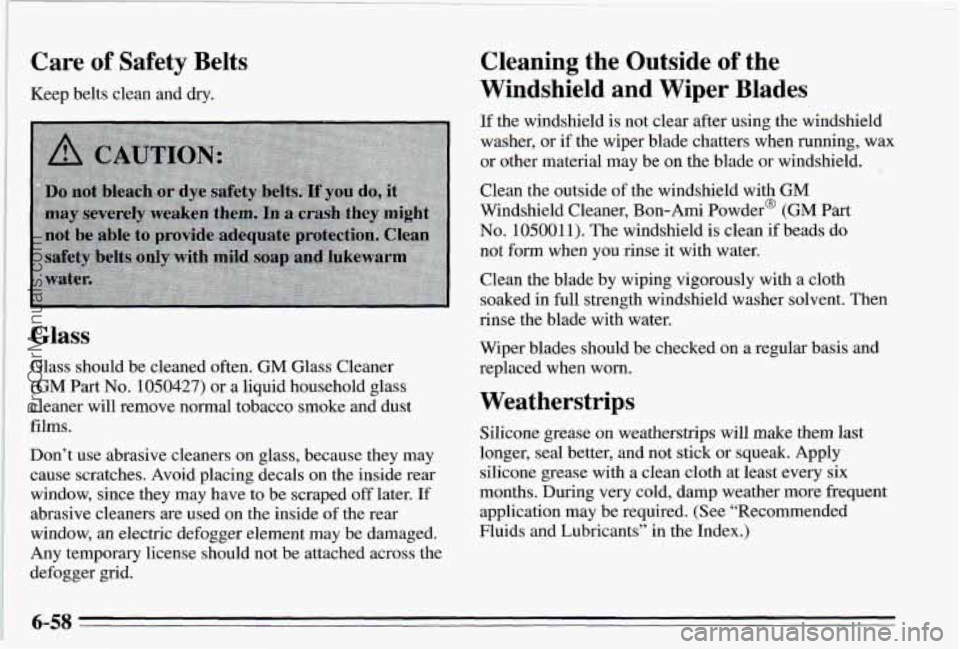
Care of Safety Belts
Keep belts clean and dry.
Glass
Glass should be cleaned often. GM Glass Cleaner
(GM
Part No. 1050427) or a liquid household glass
cleaner will remove normal tobacco smoke and dust
films.
Don’t use abrasive cleaners on glass, because they may
cause scratches. Avoid placing decals on the inside rear
window, since they may have to be scraped
off later. If
abrasive cleaners are used on the inside of the rear
window, an electric defogger element
may be damaged.
Any temporary license should not be attached across the
defogger grid.
Cleaning the Outside of the
Windshield and Wiper Blades
If the windshield is not clear after using the windshield
washer,
or if the wiper blade chatters when running, wax
or other material may be on the blade or windshield.
Clean the outside of the windshield with GM
Windshield Cleaner, Bon-Ami Powder@ (GM
Part
No. 1050011). The windshield is clean if beads do
not
form when you rinse it with water.
Clean the blade by wiping vigorously with a cloth
soaked
in full strength windshield washer solvent. Then
rinse the blade with water.
Wiper blades should be checked on a regular basis and
replaced when worn.
Weatherstrips
Silicone grease on weatherstrips will make them last
longer, seal better, and not stick or squeak. Apply
silicone grease with a clean cloth
at least every six
months. During very cold, damp weather more frequent
application may be required. (See “Recommended
Fluids and Lubricants” in the Index.)
6-58
ProCarManuals.com
Page 272 of 354
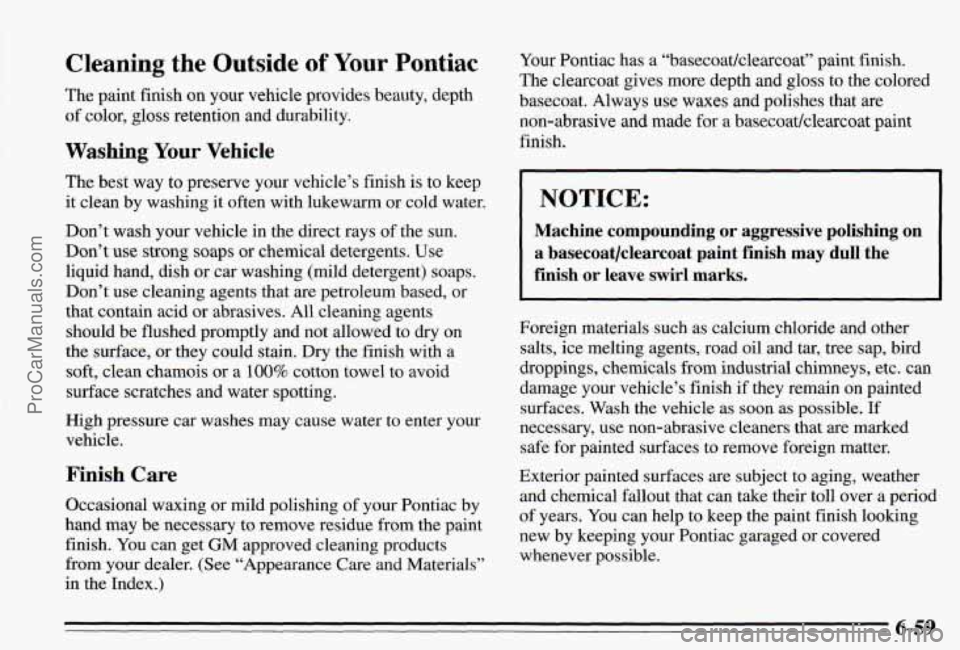
Cleaning the Outside of Your Pontiac
The paint finish on your vehicle provides beauty, depth
“ color, gloss retention and durability.
Washing Your VehicIe
The best way to preserve your vehicle’s finish is to keep
it clean by washing it often with lukewarm or cold water.
Don’t wash your vehicle in the direct rays of the sun.
Don’t use strong soaps
or chemical detergents. Use
liquid hand, dish or car washing (mild detergent) soaps.
Don’t use cleaning agents that are petroleum based, or
that contain acid or abrasives. All cleaning agents
should be flushed promptly and not allowed to dry on
the surface, or they could stain. Dry the finish with a
soft, clean chamois or a
100% cotton towel to avoid
surface scratches and water spotting.
High pressure car washes may cause water to enter your
vehicle.
Finish Care
Occasional waxing or rnild polishing of your Pontiac by
hand may be necessary to remove residue from the paint
finish. You can get
GM approved cleaning products
from your dealer. (See “Appearance Care and Materials”
in the Index.)
Your Pontiac has a “basecoatklearcoat” paint finish.
The clearcoat gives more depth and gloss to the colored
basecoat. Always use waxes and polishes
that are
non-abrasive and made
for a basecoatklearcoat paint
finish.
I NOTICE:
Machine compounding or aggressive polishing on
a basecoat/clearcoat paint finish may dull the
finish or leave swirl marks.
Foreign materials such as calcium chloride and other
salts, ice melting agents, road oil and tar, tree sap, bird
droppings, chemicals from industrial chimneys, etc.
can
damage your vehicle’s finish if they remain on painted
surfaces. Wash the vehicle as soon as possible.
If
necessary, use non-abrasive cleaners that are marked
safe for painted surfaces to remove foreign matter.
Exterior painted surfaces are subject to aging, weather
and chemical fallout that can take their toll over a period
of years. You can help to keep the paint finish looking
new by keeping your Pontiac garaged or covered
whenever possible.
6-59
ProCarManuals.com
Page 273 of 354
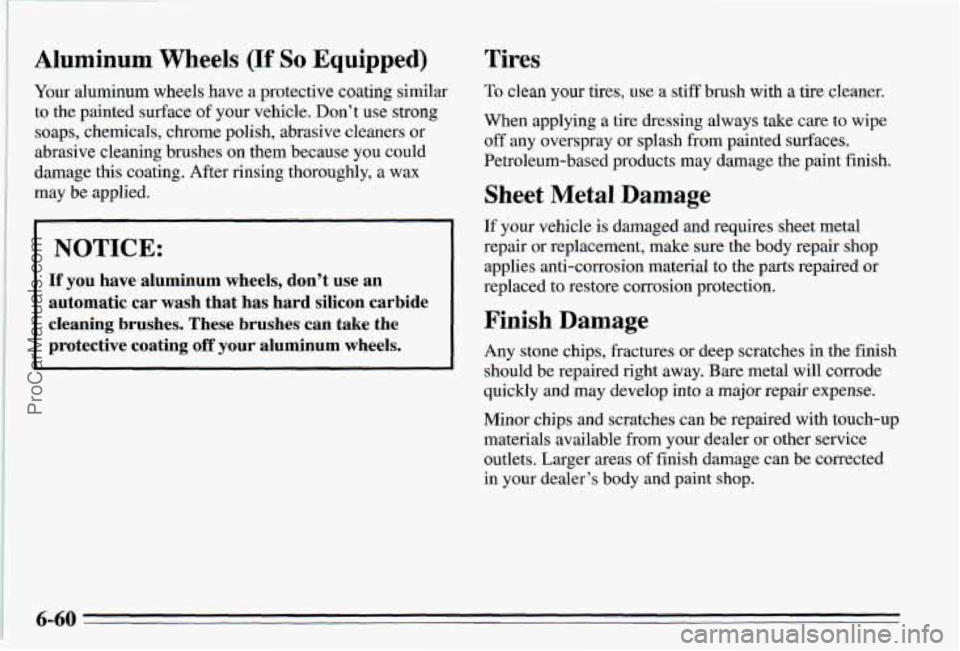
, Aluminum Wheels (If So Equipped)
Your aluminum wheels have a protective coating similar
to the painted surface of your vehicle. Don’t use strong
soaps, chemicals, chrome polish, abrasive cleaners or
abrasive cleaning brushes on them because you could
damage
this coating. After rinsing thoroughly, a wax
may be applied.
NOTICE:
If you have aluminum wheels, don’t use an
automatic car wash that has hard silicon carbide
cleaning brushes.
These brushes can take the
protective coating
off your aluminum wheels.
Tires
To clean your tires, use a stiff brush with a tire cleaner.
When applying a tire dressing always take care to wipe
off any overspray or splash from painted surfaces.
Petroleum-based products may damage the paint finish.
Sheet Metal Damage
If your vehicle is damaged and requires sheet metal
repair or replacement, make sure the body repair shop
applies anti-corrosion material to the parts repaired or
replaced to restore corrosion protection.
Finish Damage
Any stone chips, fractures or deep scratches in the finish
should be repaired right away. Bare metal will corrode
quickly and may develop into a major repair expense.
Minor chips and scratches can be repaired with touch-up
materials available from your dealer or other service
outlets. Larger areas
of finish damage can be corrected
in your dealer’s body
and paint shop.
ProCarManuals.com
Page 274 of 354
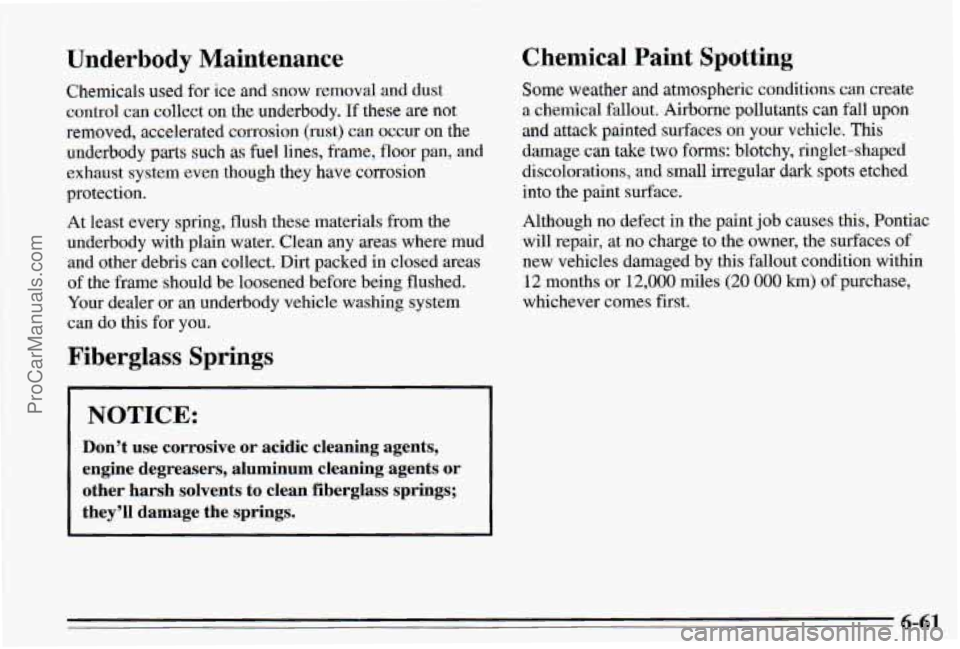
Underbody Maintenance Chemical Paint Spotting
Chemicals used for ice and snow removal and dust Some weather and atmospheric conditions CZUI create
control can collect
on the underbody. If these are not a chemical fallout, Airborne pollutants can fall upon
removed, accelerated corrosion (rust) can occur on the and
attack painted surfaces on your vehicle. This
underbody parts such as %el lines, frame, floor pan, and damage can take two forms: blotchy, ringlet-shaped
exhaust system even though
they have corrosion discolorations,
and small irregular dark spots etched
protection. into the
paint surface.
At least every spring, flush these materials from the Although no defect in the paint job causes this, Pontiac
underbody with plain water. Clean any areas where mud will repair, at
no charge to the owner, the surfaces of
and other debris can collect.
Dirt packed in closed areas new vehicles damaged by this fallout condition within
of the frame should be loosened before being flushed.
12 months or 12,000 miles (20 000 km) of purchase,
Your dealer or an underbody vehicle
washing system whichever comes first.
can
do this for you.
Fiberglass Springs
1 NOTICE: I
Don’t use corrosive or acidic cleaning agents,
engine degreasers, aluminum cleaning agents or other harsh solvents to clean fiberglass springs;
they’ll damage the springs.
6-61
ProCarManuals.com
Page 275 of 354
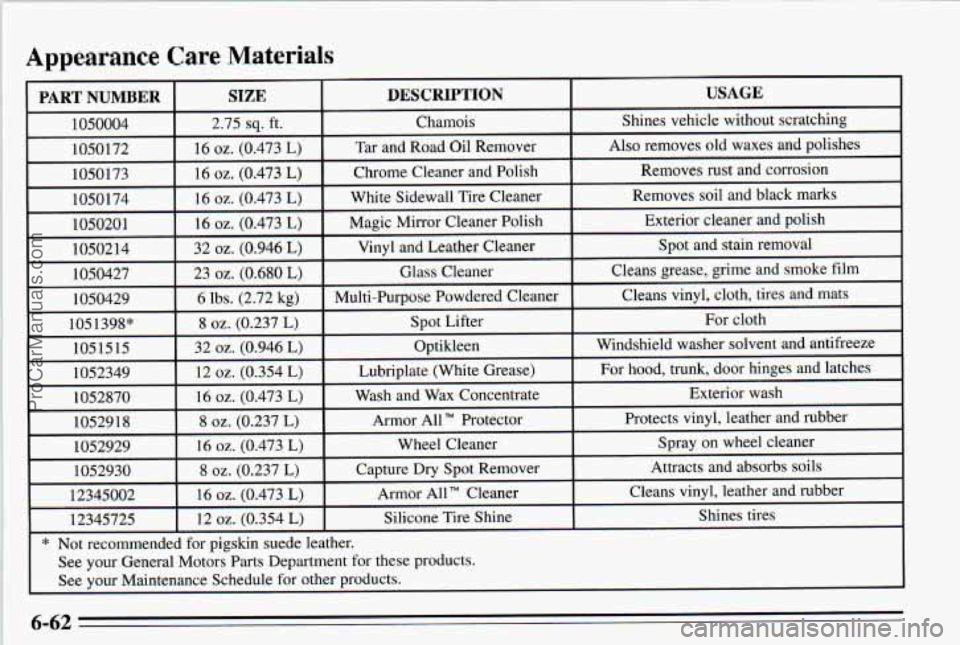
ProCarManuals.com
Page 276 of 354
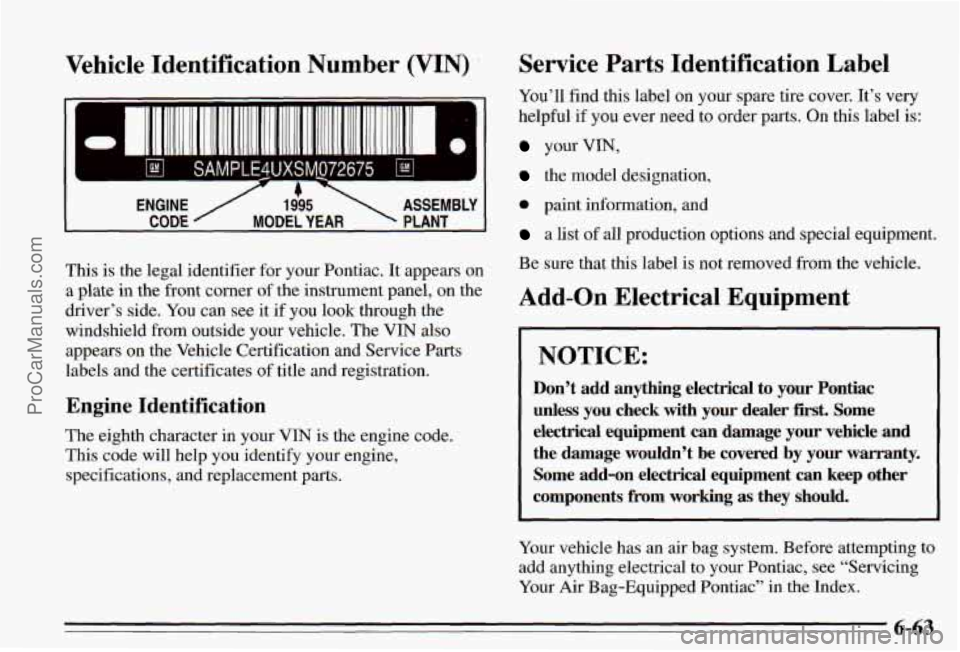
Vehicle Identification Number (VIN)
UXSMJ72675 Ictn)
4-
-- ~
1995
PLANT MODEL YEAR
ASSEMBLY
This is the legal identifier for your Pontiac. It appears on
a plate
in the front corner of the instrument panel, on the
driver’s side. You can see it
if you look through the
windshield from outside your vehicle. The
VIN also
appears on the Vehicle Certification and Service Parts
labels and the certificates of title and registration.
Engine Identification
The eighth character in your VIN is the engine code.
This code will help you identify your engine,
specifications, and replacement parts.
Service Parts Identification Label
You’ll find this label on your spare tire cover. It’s very
helphl if you ever need to order parts. On this label is:
yoLlrvIN,
the model designation,
0 paint information, and
a list of all production options and special equipment.
Be sure that this label is not removed from the vehicle.
Add-on Electrical Equipment
I NOTICE:
Don’t add anything electrical to your Pontiac
unless you check with your dealer first. Some
electrical equipment
can damage your vehicle and
the damage wouldn’t be covered by your warranty. Some add-on electrical equipment
can keep other
components
from working as they should.
Your vehicle has an air bag system. Before attempting to
add anything electrical to your Pontiac, see “Servicing
Your Air Bag-Equipped Pontiac” in the Index.
6-63
ProCarManuals.com
Page 277 of 354
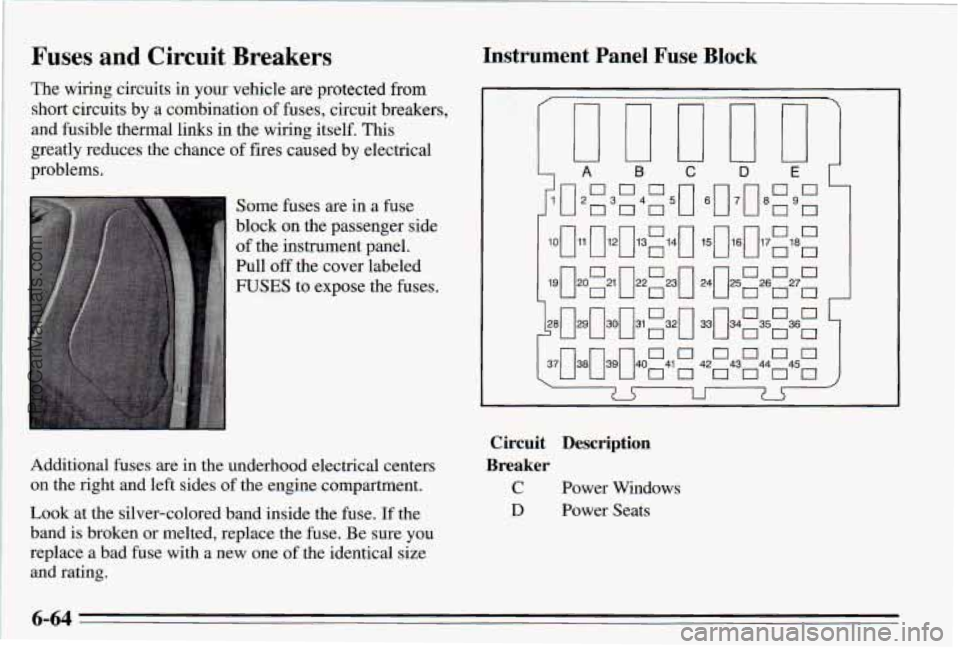
Fuses and Circuit Breakers
The wiring circuits in your vehicle are protected from
short circuits by a combination of fuses, circuit breakers,
and fusible thermal links
in the wiring itself. This
greatly reduces the chance of fires caused by electrical
problems.
Some fuses are in a fuse
block on the passenger side
of the instrument panel.
Pull off the cover labeled
FUSES to expose the fuses.
Instrument Panel Fuse Block
Additional fuses are in the underhood electrical centers
on the right and left sides of the engine compartment.
Look at the silver-colored band inside the fuse.
If the
band is broken or melted, replace the
fuse. Be sure you
replace a bad fuse with a new one of the identical size
and rating.
Circuit Description
Breaker
C Power Windows
D Power Seats
6-64
ProCarManuals.com
Page 278 of 354
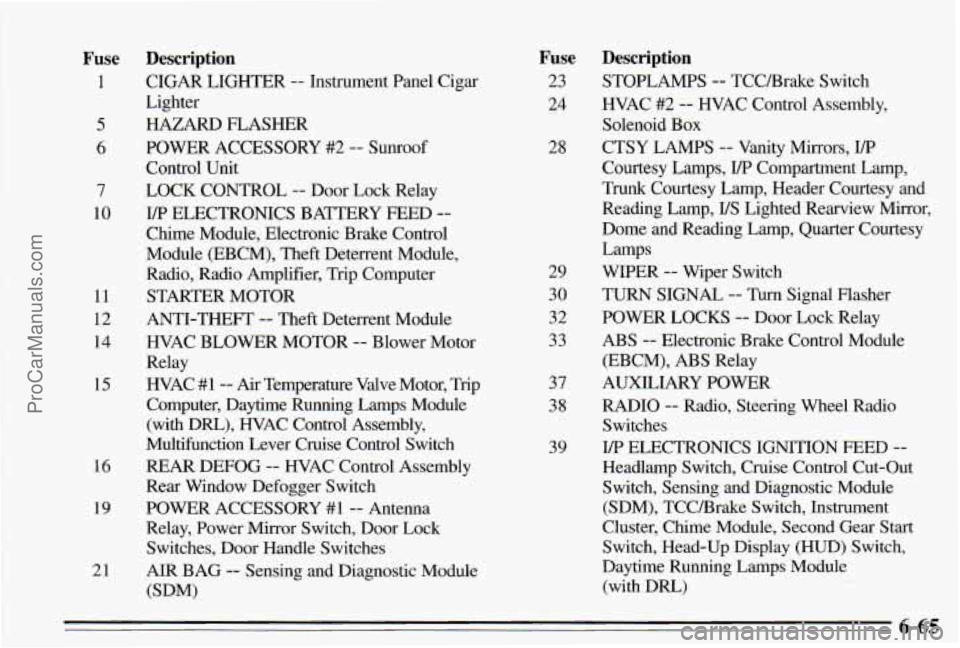
Fuse
1
5
6
7
10
11
12 14
15
16
19
21
Description
CIGAR LIGHTER -- Instrument Panel Cigar
Lighter
HAZARD FLASHER
Control Unit
LOCK CONTROL
-- Door Lock Relay
Chime Module, Electronic Brake Control
Module (EBCM), Theft Deterrent Module,
Radio, Radio Amplifier, Trip Computer
STARTER MOTOR
ANTI-THEFT
-- Theft Deterrent Module
WAC BLOWER MOTOR
-- Blower Motor
Relay
WAC
#1-- Air Temperature Valve Motor, Trip
Computer, Daytime Running Lamps Module
(with Dm), WAC Control Assembly,
Multifunction Lever Cruise Control Switch
REAR DEFOG -- WAC Control Assembly
Rear Window Defogger Switch
POWER ACCESSORY
#1 -- Antenna
Relay, Power Mirror Switch, Door Lock Switches, Door Handle Switches
AIR BAG -- Sensing and Diagnostic Module
@DM)
POWER ACCESSORY
#2 -- SUIKOO~
YP ELECTRONICS
BATTERY FEED --
Fuse
23
24
28
29
30
32
33
37
38
39
Description
STOPLAMPS -- TCCBrake Switch
HVAC #2
-- HVAC Control Assembly,
Solenoid Box
CTSY LAMPS
-- Vanity Mirrors, VP
Courtesy Lamps, I/P Compartment Lamp,
Trunk Courtesy Lamp, Header Courtesy and
Reading Lamp,
US Lighted Rearview Mirror,
Dome and Reading Lamp, Quarter Courtesy
WIPER
-- Wiper Switch
TURN SIGNAL
-- Turn Signal Flasher
POWER LOCKS
-- Door Lock Relay
ABS -- Electronic Brake Control Module
(EBCM),
ABS Relay
AUXILIARY POWER
RADIO
-- Radio, Steering Wheel Radio
Switches
Headlamp Switch, Cruise Control Cut-Out Switch, Sensing and Diagnostic Module
(SDM), TCCBrake Switch, Instrument
Cluster, Chime Module, Second Gear Start
Switch, Head-Up Display
(HUD) Switch,
Daytime Running Lamps Module
(with Dm)
Lamps
I/P ELECTRONICS IGNITION FEED --
6-65 ProCarManuals.com
Page 279 of 354
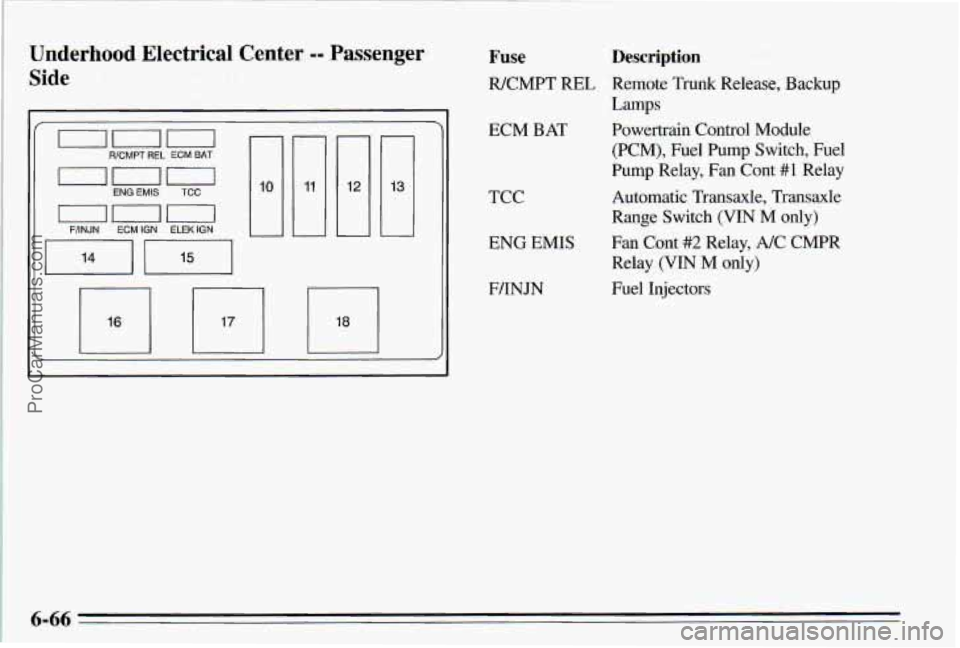
Underhood Electrical Center -- P - . er
Side
on0 ENGEMIS TCC
on0 F/INJN ECM IGN ELEK IGN
1
-
13
Fuse
WCMPT REL
ECM BAT
TCC
ENG EMIS
F/INJN
Description
Remote Trunk Release, Backup
Powertrain Control Module
(PCM), Fuel Pump Switch, Fuel
Pump Relay,
Fan Cont #1 Relay
Automatic Transaxle, Transaxle
Range Switch
(VIN M only)
Fan Cont
#2 Relay, NC CMPR
Relay
(VIN M only)
Fuel Injectors
Lamps
6-66
ProCarManuals.com
Page 280 of 354
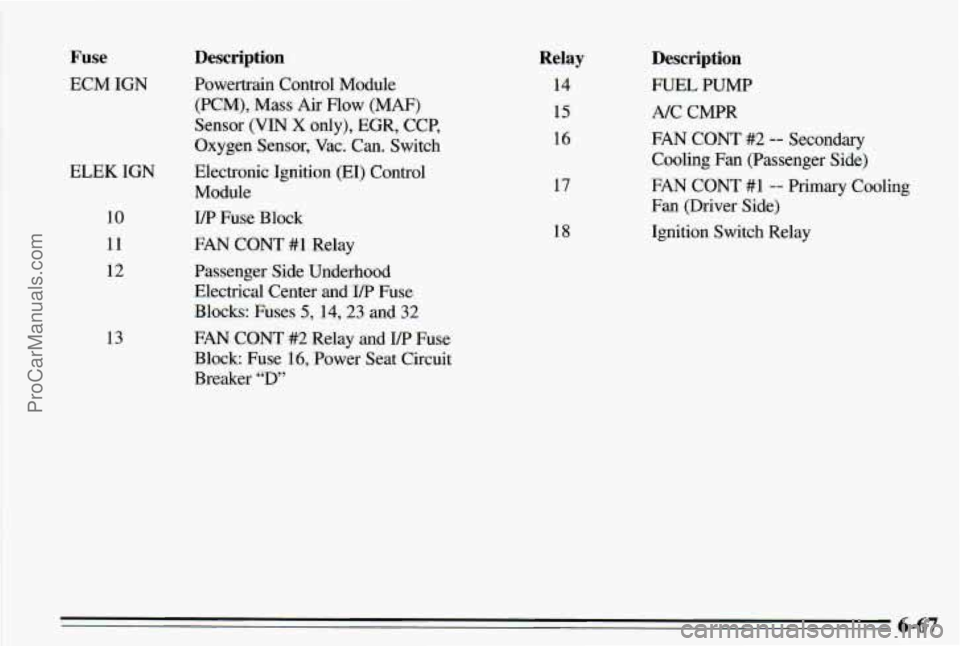
Fuse
ECM IGN
ELEK IGN
10
11
12
13
Description
Powertrain Control Module (PCM), Mass
Air Flow WAF)
Sensor (VIN X only), EGR, CCP,
Oxygen Sensor,
Vac. Can. Switch
Electronic Ignition
(EI) Control
Module
YP Fuse Block
FAN CON" #1 Relay
Passenger Side Underhood
Electrical Center and
UP Fuse
Blocks: Fuses
5, 149 23 and 32
FAN CONT
#2 Relay and I/P Fuse
Block Fuse 16, Power Seat Circuit
Breaker
'2)"
Relay
14
15
16
17
18
Description
FUEL PUMP
AfC
CMPR
FAN CONT #2 -- Secondary
Cooling
Fan (Passenger Side)
Fan (Driver Side)
Ignition
Switch Relay
FAN CON" #1-- P1-ima.r~ Coohg
6-67 ProCarManuals.com